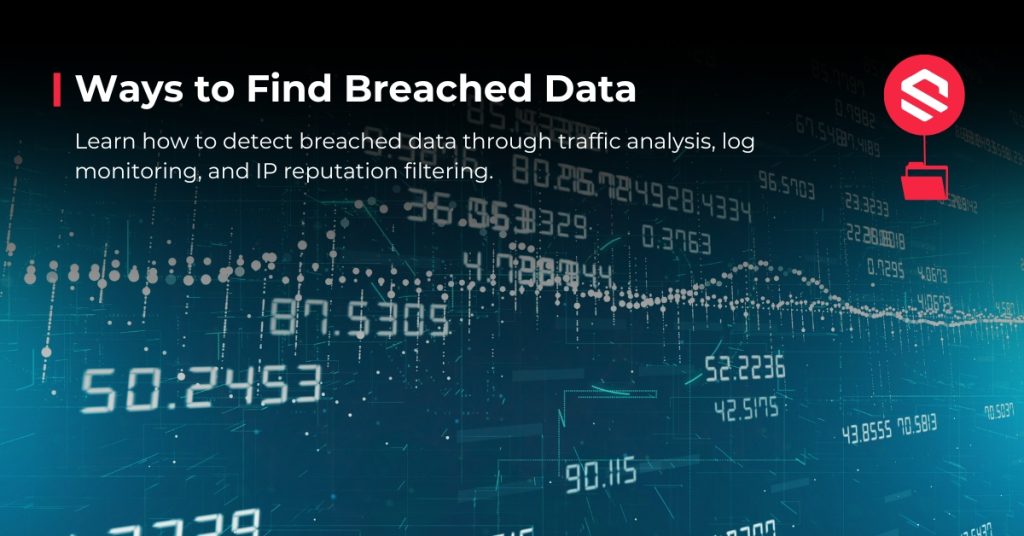Detecting a data breach doesn’t always mean finding your information leaked on the internet. Often, the most important signs are inside your own infrastructure: an unusual access pattern, an unexplained massive download, or a suspicious IP that keeps trying to connect. Knowing how to read these signals is key to acting before the data actually leaves your system.
In this article, we go over the most effective ways to identify active or past breaches, how to analyze them, and what tools can help reduce risk and contain damage.
How to Know If You’re Experiencing a Data Breach
Breaches don’t always leave clear traces, but they often show signs — if you know where to look.
One of the first steps is reviewing the behavior of users and services accessing your data:
- Are there connections outside usual working hours?
- Are sensitive or rarely accessed resources being requested repeatedly?
- Has the volume of downloads increased unexpectedly?
Add to this the analysis of logs. System logs, load balancer records, web requests, or incoming connection logs can reveal abnormal patterns. Traffic spikes from a single IP, constant requests to the same resource, or repeated errors may indicate malicious activity.
The key is spotting what deviates from the norm. And to do that, you need real-time visibility over your traffic and access logs.
How to Analyze Suspicious Behavior
It’s not enough to log data — you have to interpret it. Behavioral analysis involves comparing current activity with your network’s usual patterns. If your users normally access specific routes at certain times, any deviation might be a red flag.
Another layer is correlation with external information. For instance, many platforms (like SKUDONET) can cross-reference incoming IPs with reputation databases to check whether they’re linked to known attacks, botnets, or malicious activity. SKUDONET includes more than 260 updated IP blacklists natively for this purpose.
It’s also critical to correlate data from different systems. A strange request in your firewall log is one thing — but seeing that same IP hit your login, your API, and your file downloads paints a clearer picture. The more sources you analyze, the more precise the pattern.
How to Prevent a Data Breach Before It Happens
Many breaches can be avoided by strengthening basic practices:
- Keep systems patched and up to date. Most intrusions exploit known vulnerabilities that already have fixes available.
- Inspect encrypted traffic. Today, over 80% of web traffic is encrypted. If you’re not inspecting it, you’re flying blind. This requires solutions that can analyze HTTPS connections without compromising performance, privacy, or stability.
- Combine intrusion detection and prevention. It’s not enough to block what’s clearly malicious — you need to detect suspicious behavior in real time. That’s where IDS (Intrusion Detection System) and IPS (Intrusion Prevention System) come in. Modern platforms like SKUDONET combine both in a unified IPDS engine, allowing fast, accurate responses.
How SKUDONET Helps Detect and Contain Breaches
SKUDONET is not a generic analysis tool — it’s an Application Delivery Controller (ADC) with advanced built-in security features. What does that mean? It acts exactly at the point where all your traffic flows — where you can see it, filter it, and stop it if needed. It also includes a fully integrated, advanced Web Application Firewall (WAF), with no extra configuration or external modules required.
With SKUDONET you can:
- Inspect TLS/SSL encrypted traffic natively, without relying on external tools.
- Control traffic at Layers 4 and 7, applying custom rules on requests, headers, downloads, or routes.
- Filter traffic based on reputation using integrated IP blacklists (over 260 lists available).
- Detect and prevent attacks in real time with its built-in IPDS engine (IPS + IDS)
- Audit access and analyze logs through a clear and user-friendly interface.
All this comes without extra modules or hidden costs. TLS inspection, bot mitigation, encrypted traffic visibility, certificate control — it’s all included from day one, with no fragmentation.
Finding a breach doesn’t always mean checking if your email appears in a leaked database. Often, the signs are already there — in the logs, the traffic, the repeating patterns.
With tools that combine visibility, control, prevention, and analysis — like SKUDONET — it’s possible to detect threats before they become real leaks. And to do it without expensive solutions or complex infrastructure.
Because protecting your data shouldn’t be a luxury — it should be a natural part of your daily operations.
Want to see how SKUDONET protects your traffic in real time? Try our fully-featured Enterprise Edition for 30 days — no commitment, with full technical support included.
Not ready yet? Explore how SKUDONET inspects TLS/SSL traffic and stops threats at the edge.


